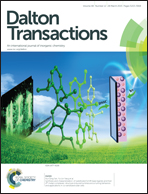Spectroscopic, computational and electrochemical studies on the formation of the copper complex of 1-amino-4-hydroxy-9,10-anthraquinone and effect of it on superoxide formation by NADH dehydrogenase†
Abstract
A 1 : 2 copperII complex of 1-amino-4-hydroxy-9,10-anthraquinone (QH) having the molecular formula CuQ2 was prepared and characterized by elemental analysis, NMR, FTIR, UV-vis and mass spectroscopy. The powder diffraction of the solid complex, magnetic susceptibility and ESR spectra were also recorded. The presence of the planar anthraquinone moiety in the complex makes it extremely difficult to obtain a single crystal suitable for X-ray diffraction studies. To overcome this problem, density functional theory (DFT) was used to evaluate an optimized structure of CuQ2. In the optimized structure, it was found that there is a tilt of the two planar aromatic anthraquinone rings of the complex with respect to each other in the two planes containing the O–Cu(II)–O plane. The present study is an important addition to the understanding of the structural aspects of metal-anthracyclines because there are only a few reports on the actual structures of metal-anthracyclines. The theoretical vibrational spectrum of the complex was assigned with the help of vibrational energy distribution analysis (VEDA) using potential energy distribution (PED) and compared with experimental results. Being important in producing the biochemical action of this class of molecules, the electrochemical behavior of the complex was studied in aqueous and non-aqueous solvents to find certain electrochemical parameters. In aqueous media, reduction involves a kinetic effect during electron transfer at an electrode surface, which was characterized very carefully using cyclic voltammetry. Electrochemical studies showed a significant modification in the electrochemical properties of 1-amino-4-hydroxy-9,10-anthraquinone (QH) when bound to CuII in the complex compared to those observed for free QH. This suggests that the copper complex might be a good choice as a biologically active molecule, which was reflected in the lack of stimulated superoxide generation by the complex.


 Please wait while we load your content...
Please wait while we load your content...